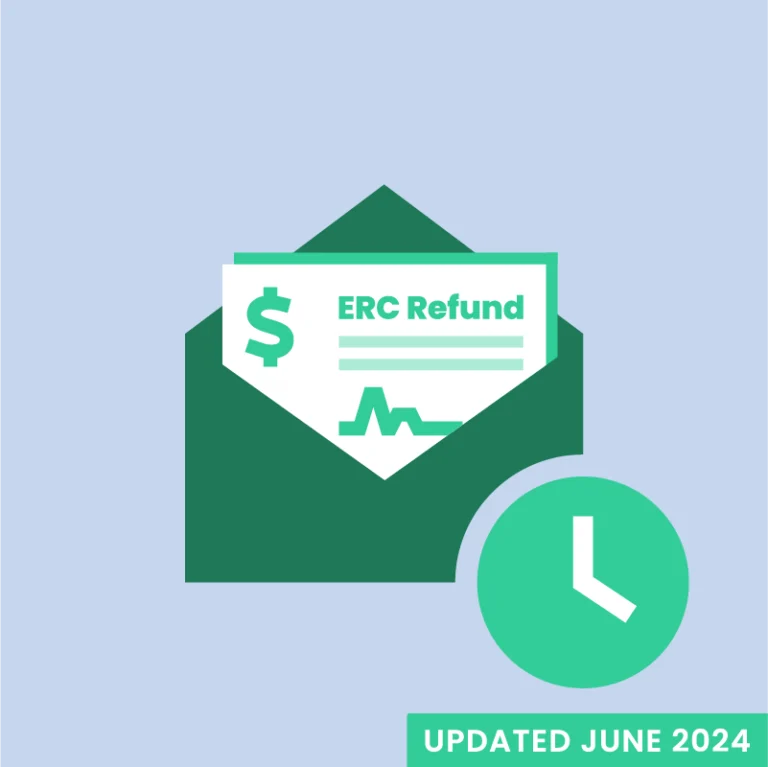Small businesses are grappling with a pressing question in 2024: how long will it take the IRS to process their Employee Retention Credit (ERC) claims? The ERC was a crucial lifeline for employers during the COVID-19 pandemic. However, as the new year unfolds, ongoing concerns at the IRS continue to delay the processing and issuance of employers’ payroll tax refunds.
This article discusses the current reality at the IRS, expectations surrounding the ERC program, and what it all means for employers with legitimate claims still pending.
How the ERC Moratorium Is Affecting Processing Times
On September 14, 2023, the IRS declared a moratorium on the processing of new ERC claims. Initially set to last until December 31, 2023, the pause remains in effect as of June 20, 2024, with no definite end date announced.
We decided to keep the post-September moratorium in place because we continue to be concerned about the substantial number of claims coming in so long after the pandemic.
DANIEL WERFEL, U.S. COMMISSIONER OF INTERNAL REVENUE
The primary driver behind the IRS’s decision is an intensified focus on ERC fraud detection and determent. This is evidenced, in part, by the agency’s new enhanced compliance review procedure for identifying and responding to improper and potentially fraudulent claims. Unfortunately, such measures have resulted in slower processing times for pre-moratorium filings. The IRS now states a processing goal of 180 days or much longer if further review, more information, or an ERC audit is needed.
How Long You Must Wait for Your Payroll Tax Refund
What we’re seeing is that employers who filed their ERC claims before the moratorium are waiting 18 months or more for their first check or deposit to arrive. Employers may even receive their refund for one quarter but still have several additional quarters pending. On the other hand, employers who filed their claims after the moratorium are being added to the IRS’s post-moratorium backlog and are receiving no further information.
The IRS’s ERC Backlog Is Shocking (and It’s Still Increasing)
According to the latest IRS data, there were 1,057,000 unprocessed ERC claims as of December 9, 2023, a notable increase from 637,000 pre-moratorium. The IRS approximates it’s receiving 17,000 new applications per week as of June 2024. Assuming the same pace since last December, the IRS has received over 400,000 more applications, bringing the total backlog of unprocessed ERC claims to roughly $1.5 million.
How Recent ERC Legislation Is Affecting Processing Times
Earlier this year, the Tax Relief for American Families and Workers Act of 2024 (TRAFWA) was passed by the House of Representatives but has since stalled in the Senate. If the TRAFWA had been signed into law, it would’ve retroactively ended the ERC program as of January 31, 2024. The bill would’ve also extended the IRS’s assessment period from five to six years and increased its capacity to penalize ERC promotors and instances of willful fraudulence. Although the TRAFWA seems unlikely to move forward, there’s a possibility that elements of the bipartisan bill could make their way into a larger tax reform initiative following this year’s election.
Reasons Why the IRS May Be Biding Time
From the IRS’s perspective, the retroactive sunset of the ERC program would save $77.1 billion — which is the essential funding mechanism for the TRAFWA’s $77.5 billion in costs. If the agency begins issuing ERC refunds for applications that were submitted after January 31, 2024, it will effectively eliminate the prospect of the TRAFWA passing altogether.
Another of the IRS’s concerns — and likely reasons for dragging its feet — has to do with “COVID-ERTC promoters.” Without the controls provided under the TRAFWA, the agency worries that a portion of its ERC payouts to employers will be collected by promoters as contingency fees and reinvested in more aggressive marketing. As the 2021 ERC deadline of April 15, 2025, looms, the IRS likely isn’t eager to make promoters’ jobs any easier.
Tax fraud is defined as an “intentional wrongdoing, on the part of a taxpayer, with the specific purpose of evading a tax known or believed to be owing.” This is a very high bar. Despite the IRS’s routine press releases asserting tax fraud and Commissioner Werfel stating “19 out of every 20 claims is suspect,” it is improbable that the majority of ERC claims are fraudulent. This is why many practitioners are skeptical. However, the rhetoric the IRS has used to justify its handling of ERC claims and support the passing of the TRAFWA may inhibit the agency’s ability to issue refunds more quickly.
Growing Pressure on the IRS to Act
The Taxpayer Advocate Service (TAS), an independent organization within the IRS, is one of the key voices urging the agency to be more proactive and expeditious in handling employers’ payroll tax refunds. In the National Taxpayer Advocate’s 2023 Annual Report to Congress, the IRS was cited as receiving about 45,000 new ERC claims per week while only processing 150 ERC claims per week from mid-August through mid-October 2023. The report argued that there is simply too high a volume of ERC claims coming in, many of which are legitimate, for the IRS to continue at its current pace and with its current strategy.
Commissioner Werfel testified at a House Ways and Means Committee hearing in March 2024 that the IRS is now processing 1,000-2,000 ERC claims per week. However, Congresswoman Claudia Tenney pointed out in a letter to Commissioner Werfel on June 11, 2024, that “at that rate, it would take the IRS more than 10 years to process outstanding ERC claims.”
Senator Thomas Tuberville voiced his concerns about the IRS’s moratorium and sluggish processing times in a letter to Commissioner Werfel on June 13, 2024.
It is unacceptable to continue punishing American employers who fought through an unprecedented disruption to their businesses while keeping employees on payroll.
THOMAS TUBERVILLE, U.S. SENATOR (R-ALA)
Senate Republicans opposed to the TRAFWA in its current form have challenged the bill’s reliance on using unrealized savings from the ERC to offset its costs and expressed concerns about employers with legitimate claims being negatively impacted if Congress were to terminate the program early.
In a more recent development, some ERC claimants have chosen to file lawsuits for their refunds in federal district court.
How to Look Up Your ERC Refund Status
The best way to check the status of your ERC refund is to call the IRS directly at +1 (800) 829-4933. Be sure you have the following information on hand before you call:
- Your Business’s Federal Identification Number
- Which Quarters’ Returns Were Amended (the Quarters You Claimed an ERC Refund for)
- Approximate Date(s) You Mailed Your Amended Returns
- Estimated ERC Refund Amounts for Each Quarter
Note that you may experience long hold times, and not all IRS agents will be able to assist you.
What Other Options Are Available to ERC Claimants
If you’ve already tried speaking to the IRS regarding the status of your ERC claim, you have three options.
As the duration of time from the initial filing continues to increase, [contacting the TAS, filing a lawsuit, or applying for an advance] may be preferable to the ‘sit and wait’ approach, as the IRS is not bound to a time period to process the claims for refund.
JUSTIN ELANJIAN, MANAGING DIRECTOR AT STOUT
Option #1: Reach Out to the TAS for Assistance
The TAS may be a good course of action if you can demonstrate that the IRS’s delay in issuing your ERC refund is causing your business harm. It’s working with the IRS to prioritize ERC claims from employers with a substantial need. You can reach the TAS at +1 (877) 777-4778.
Option #2: File a Lawsuit for Your ERC Refund
Since the IRS isn’t legally obligated to issue your refund within a specified amount of time, litigation may be preferable. Section 6532 of the Internal Revenue Code grants taxpayers the authority to file a lawsuit in federal court if the IRS has (1) failed to process the claim within 180 days or (2) provided a notice of disallowance. For the latter, there’s a 2-year window to file a lawsuit. For unprocessed claims, the timeline is less clear.
Keep in mind that suing the government for your ERC refund will come with greater scrutiny and cost. You should consult a tax attorney to determine whether this option is appropriate for your claim.
Option #3: Apply for ERC Bridge Financing
Applying for an ERC advance is, for many claimants, the path of least resistance. This option allows you to finance or sell a portion of your ERC refund amount in exchange for cash upfront. 1st Capital Financial is the industry leader in ERC financing. We encourage you to submit an ERC Financing Form online or call us to learn more.
Final Thoughts on ERC Refund Delays
The unpredictability of the IRS’s ERC processing times in 2024 underscores the importance of preparing for ongoing delays. It’s unfortunate that cash-starved businesses should have to consider alternate recourse for obtaining the payroll tax refund they are entitled to, but it’s the reality of the situation. The IRS is unlikely to lift the ERC moratorium and begin processing claims at the rate it was before. All the evidence suggests that the IRS will only seek more enforcement capability. But who knows, growing pressure from the public and a myriad of docketed ERC cases in federal district court may just be enough to force the IRS’s hand.
Get an Advance on Your ERC Refund





